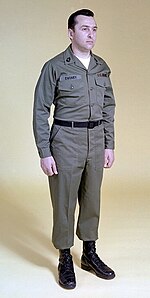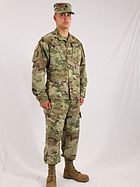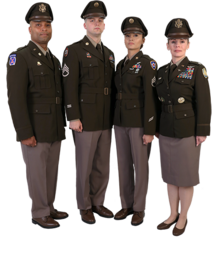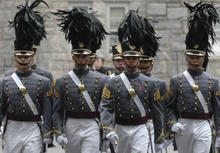How To Put Rank On Army Service Uniform
The uniforms of the United States Regular army distinguish soldiers from other service members. U.S. Army uniform designs have historically been influenced by British and French military traditions, besides as contemporary U.Due south. noncombatant mode trends. The two primary uniforms of the mod U.S. Regular army are the Army Combat Uniform, used in operational environments, and the Army Green Service Uniform worn during everyday professional wear and during formal and ceremonial occasions that practise not warrant the article of clothing of the more formal blue service uniform.
History [edit]

The blueprint of early army uniforms was influenced by both British and French traditions. One of the first Regular army-wide regulations, adopted in 1789, prescribed blueish coats with colored facings to place a unit'due south region of origin: New England units wore white facings, southern units wore blueish facings, and units from Mid-Atlantic states wore red facings.[1] Bandsmen wore red uniforms to make them more easily identifiable to commanders on the field of battle. Pantaloons were originally white, following British uniforms, just were changed to gray in 1821 and sky blue in 1832. Infantry wore tricorne hats, with different encompass prescribed for cavalry and specialist troops depending on function.
The original Revolutionary War enlisted uniform jacket was dark blue with country-specific facing colors. This was worn with a white waistcoat and breeches and black shoes. All ranks wore a blackness tricorne chapeau with a black cockade; later a white cockade was inset to represent the American alliance with Bourbon France. From 1782, Regulars had red facings. Foot regiments (infantry, artillery, and supporting units) wore gold-metal buttons and lace. Horse regiments (cavalry, low-cal dragoons, and equus caballus artillery) wore white-metallic buttons and lace.
From 1810, the uniform changed to follow European trends. The tight-plumbing equipment and short-skirted double-breasted coatee replaced the unmarried-breasted coat, and the waistcoat was discontinued. Militia wore gray coatees (still worn as a ceremonial compatible at West Point today) and regulars wore national blue (dark-blue) coatees (except for musicians, who wore reversed cerise coatees with blue facings). Enlisted ranks wore the coatee with a black stovepipe shako, white or gray trousers with matching button-up spats, and black short boots. Facings and buttonhole trim were discontinued in 1813. From the early days of the Continental Regular army the wearing of a sword and a worsted scarlet sash served as a badge of rank for all sergeant grades, but by 1820 the worsted sash became a privilege to first sergeants and above only (from 1781, until 1833, the "get-go sergeant" was simply the senior sergeant in a company or battery and was not a separate class of rank).[ii]
Start in the 1850s, U.S. military leadership began to place an increased accent on French army tactics and styles, influenced, in part, past the rise of Napoleon 3.[3] The most extreme examples showing the adoption of French military machine fashion was in the apply of zouave uniforms by some U.Southward. Army infantry regiments, and the buy of 10,000 chasseurs à pied uniforms to outfit the Excelsior Brigade.[4] However, more than subtle styling - including frock coats, kepi hats, and collar ornaments - were more common during and later the American Civil State of war.

Infantry uniforms in 1899
Beginning in 1902, the Ground forces made khaki and olive drab field uniforms standard upshot, having seen their effectiveness in limited use during the Spanish–American War, while the traditional blue was reserved for dress uniforms. Uniforms used during Globe War I remained essentially like to the 1902 patterns, but blueish uniforms were suspended during the disharmonize. During the inter-state of war catamenia, piecemeal modifications were made to the designs, such equally the introduction of open-collar coats, straight-legged trousers, and collared shirts with ties, resulting in uniforms that by the end of the 1930s were entirely different. A blue dress uniform was reintroduced in 1937.

U.S. Regular army Air Forces officers wearing the "pinks and greens" compatible used during Globe War II
The U.S. Ground forces uniforms used during World State of war Two saw a deviation betwixt field and garrison service elements, the latter necessitated by the suspension of the blue dress uniform over again, leading to them becoming dissever classes of uniforms by the end of the war. These uniforms connected in employ into the Korean War.

The OG-107 field uniform was used for virtually xxx years.
The OG-107 gainsay compatible was introduced as the new standard field compatible during Korea, and continued as the standard fatigue duty uniform for almost three decades. It saw small-scale changes through its lifespan.

Army green Form "A" service uniforms, introduced in 1954 and retired in 2015
In 1954, the Army Light-green Uniform, also chosen the "Course A" compatible, was introduced for garrison dress.[5] An alternate semi-clothes compatible for the summer months, the Ground forces Tan Uniform, connected in use until 1985, though was relegated to Class B status following the mid 1960s. The blue dress compatible, at present mandatory for officers and an authorized option for enlisted soldiers, was reinstated in 1957.
The OG-107 field uniform was replaced in 1981 by the Boxing Dress Compatible and Desert Battle Dress Compatible (later the Desert Cover-up Uniform), which saw utilise during the Gulf War. These were in plough replaced past the Army Combat Uniform (ACU) in the mid-2000s, during the War in Transitional islamic state of afghanistan and War in Iraq. When initially introduced, the ACU used the Universal Cover-up Pattern; this proved to be an ineffective pattern and was replaced showtime in 2014 with the more constructive Operational Cover-up Pattern. Equally of 2021[update], the ACU in OCP is the standard issue field uniform of the Army.

The new Regular army Green Service Compatible will be a general service uniform while the Ground forces Bluish Service Compatible (center) volition return to its former utilize as a ceremonial and parade uniform.
Beginning in 2010, the bluish Regular army Service Uniform (ASU),[6] previously used as a formal clothes uniform, displaced the dark-green Class A uniform as the daily wear service uniform. This move proved unpopular, and in 2018 a new Army Light-green Service Uniform modeled after World War Ii-era officers garrison uniforms was announced. By 2028 all soldiers volition be wearing the green ASU equally role attire. The blue compatible will remain the ceremonial and formal wearing apparel uniform.[7]
Current designs [edit]
Standard uniforms [edit]
Combat uniform [edit]

A soldier wearing the Army Combat Uniform
The Army Combat Uniform (ACU) is the utility compatible worn in garrison and in combat zones past the U.S. Regular army. It consists of a jacket and trousers in the Operational Camouflage Pattern (OCP), worn with gainsay boots and a t-shirt. A matching patrol cap replaced the black beret for habiliment with the ACU in July 2011. In the field, the jacket may be replaced by the flame resistant Army Combat Shirt when worn directly under a tactical vest. The ACU jacket bears proper name tapes, rank insignia, and shoulder patches and tabs, as well equally recognition devices such as a U.Due south. flag patch and the infrared (IR) tab. Two U.S. flag insignia are authorized for wear with the ACU, full-color and subdued IR. The U.South. flag insignia is worn on the right shoulder pocket flap of the ACU glaze. Unit of measurement patches are worn on the left shoulder, while gainsay patches are worn on the right. The proper noun tapes, rank, and skill badges are either secured with hook-and-loop fasteners or can optionally be sewn on.
The ACU was introduced in 2005, replacing the previous Boxing Wearing apparel Uniform and Desert Camouflage Uniform. The uniform originally featured a pixelated camouflage pattern, known as the Universal Camouflage Blueprint (UCP), which was designed for use in woodland, desert, and urban environments.[viii] However, the pattern was institute unsuitable, and beginning in 2010, almost soldiers operating in Afghanistan were issued ACUs using the commercial MultiCam design, which was found to be better suited to that country's terrain.[9] Afterwards, the OCP, which is similar to MultiCam, was adopted Regular army-wide starting in 2015, with UCP fully retired in 2019.
Service uniform [edit]

The Ground forces Green Service Uniform
The current garrison service uniform is known every bit the "Army Dark-green Service Uniform".[10] Introduced in belatedly 2018, it is based on the "pinks and greens" officers' service uniform worn in World War Two and the Korean War.[7] [11] The service uniform includes a dark olive drab coat, light drab trousers, a khaki shirt, an olive drab tie, and brown leather shoes for both men and women, with women having the option to clothing a pencil brim and pumps instead.[12] The uniform became bachelor to soldiers in mid-2020.[13]

The Army Blue Service Uniform. The blue and gold ceremonial chugalug is not mostly worn by all units
From 2010 to 2020, a blue uniform, known as the Regular army Bluish Service Uniform, was used as the daily habiliment service uniform. The Army has a tradition of blue uniforms dating to the Revolutionary State of war, and the bluish uniform returns to its previous position as a formal dress and ceremonial uniform. It had replaced in daily wear the previous green service uniform used by all officers and enlisted personnel introduced in 1956.[14] [xv]
Mess uniform [edit]

Colonel Palmatier in the "Special Evening Dress" worn as an optional alternative to the Army Mess Uniform past officers from 1902 to 1969
Mess apparel is the war machine term for the formal evening dress worn in the mess or at other formal occasions. This is by and large worn as the military equivalent of white tie or blackness tie. The Army has two versions, a bluish winter version and a white summer version, each worn with different accessories depending on the formality of the occasion.
The bluish mess uniform comprises the Army blue mess jacket, high-waisted trousers, white semiformal clothes shirt with a turndown collar, black bow tie, and blackness cummerbund. The blue trousers are cutting along the lines of civilian apparel trousers, with a high waist and without pleats, cuffs, or hip pockets. The trouser leg ornamentation consists of an ornamental braid worn on the outside seam of the trouser leg, from the bottom of the waistband to the lesser of the trouser leg. General officers wear pants of the same color equally the jacket, with two ½–inch, aureate-colored braids, spaced ½ inch apart. Electric current stated uniform regulation for mess apparel is that all other officers and enlisted personnel wear lighter blueish trousers with a unmarried 1 ½ inch, gold-colored braid. When worn for white tie events, it is worn with a white formal dress shirt with a wing collar, white waistcoat, and white bow necktie instead of the black tie versions.
The white mess compatible is similar, but features a white mess jacket and black high-waisted trousers instead. The trousers are the same for all ranks.
Physical training uniform [edit]

The Army Physical Fettle Uniform in warm-weather configuration
The Army Physical Fitness Uniform (APFU), manufactured by UNICOR and adopted in 2013, is modular, with individual pieces that tin be combined or eliminated depending on physical grooming conditions. All parts of the compatible are styled in blackness and gold and include rails jacket, short-sleeve and long-sleeve T-shirts, track pants, and stretchable running trunks. The uniform was released on October 1, 2014. No standard shoe style is specified to be worn; soldiers are expected only to purchase commercial running shoes. Shoes with profane or vulgar logos, however, as well as "toe shoes" (such as the Vibram FiveFingers running shoe), are prohibited.[16]
Special ceremonial units [edit]
U.S. Regular army uniform regulations define a class of "special formalism units" (SCUs), which include guards units and bands, that are authorized to wear distinctive uniforms – in lieu of the Army Service Compatible – for public duties, including land arrivals, official funerals, change-of-command and retirement ceremonies, and the presidential inaugural parade.
Examples of SCU uniforms
-

Uniform of a drum major in the 3rd Infantry Regiment Fife and Drum Corps
-

-

-

Compatible of a U.S. Regular army Herald Trumpeter
-

Compatible of a U.Southward. Ground forces Special Bandsman
-

Uniform of a U.South. Ground forces Special Ring pulsate major
Bands [edit]
The U.S. Army has 34 active-duty bands and more than than l reserve bands. Almost of these units wear the Army Service Uniform for public duties, nonetheless, certain units – primarily located in the National Capital Region – have unit of measurement-specific uniforms that are used for special occasions. Dissimilar the Army Service Compatible, these specialized uniforms are, for budgetary reasons, more often than not issued to units – instead of individuals – and returned to the unit of measurement following the soldier's deviation.
The U.S. Army Band "Pershing's Own", the U.Due south. Army Field Band, and the U.S. Army Herald Trumpets wear a parade uniform designed by the U.S. Army Institute of Heraldry and introduced in 1969 for the inauguration of Richard Nixon. The uniform blouse has a choker-way collar, instead of the open collar used on the Army Service Uniform, and viii buttons, representing the eight notes of the musical scale. Decorative gold braid adorns the cuffs and standard army cover is replaced past a cherry peaked hat, while drum majors wear a bearskin helmet. A summer white blouse is likewise available.[17] In the 1950s "Pershing's Own" briefly wore a yellow and black compatible known equally "the Lion Tamer" due to its resemblance to a circus costume. Before World State of war II, the band's uniform was a grey variation of the standard dress blue uniform.
The 3rd Infantry Regiment Fife and Drum Corps wear red, open up-front regimental coats, white coveralls, and black tri-corner hats.
The U.S. Military Academy Band – a full-time band assigned to the U.S. Military Academy at Due west Point - wears distinctive, high-collared navy jackets with white accessories and nighttime shakos. From 1875 to 1890 the ring wore pickelhaube instead of shakos.
Guards [edit]
The Commander-in-Primary'southward Baby-sit, part of the 3rd Infantry Regiment, uses a special dress compatible that is evocative of the uniform worn by Gen. George Washington'due south life baby-sit. Information technology consists of open-front, blue regimental coats, white coveralls, and black tricorner hats.
The Offset Troop Philadelphia City Cavalry (a Pennsylvania National Guard unit) has a special full-dress uniform known for its distinctive helmet with extravagant bearskin roach.[18]
The 1st Cavalry Division's Equus caballus Detachment was given status every bit a Special Ceremonial Unit in 1972. Their parade uniform consists of a navy "fire-eater'south shirt", worn with Columbia blue trousers with yellow pipe. Accoutrements include a divisional kerchief worn around the cervix and yellow suspenders. Cover is the Cavalry Stetson.
Other non-band SCU units with distinctive uniforms include 54th Massachusetts Volunteer Infantry.
Cadet uniforms [edit]

U.S. Military Academy cadets in bound parade uniform
West Point [edit]
Cadets enrolled at the United States Military University at Due west Bespeak wear standard Army uniforms, including the Ground forces Combat Uniform and the Army Physical Fitness Compatible, just also employ several unique uniforms for drills and daily habiliment in lieu of the Army Service Uniform. Since 1816, West Point cadet uniforms have been styled in buck grey which continues to exist the primary colour used in academy dress.
Spring parade dress consists of cadet grey swallow-tail coats with 21-gold buttons, a continuing collar, white trousers, and black shakos (known as a "tarbucket hat" in U.S. Ground forces nomenclature). Winter parade apparel is similar to bound parade clothes, though trousers are colored cadet gray instead of white. This same compatible is worn without the blackness shakos hat and with the greyness or white peaked service cap depending on the flavour when not parading but still required for formal events. For evening formal events, no headgear is worn. Summer dress ("Bharat Whites") consist of a white overblouse with a standing collar, white trousers and white peaked service caps. Service wearing apparel ("white over gray") consists of grey trousers, brusque sleeve white shirts with shoulder boards, and white peaked caps. "Dress Grayness" uniforms consist of gray blouses with a standing neckband and trimmed with a one-inch black mohair braid band, gray trousers and gray peaked caps. In common cold weather, a gray Long Overcoat is worn over the uniform. The daily service uniform ("As for Class") consists of gray trousers, charcoal grayness shirts in long sleeve and brusk sleeve variants and garrison caps.[19]
Senior war machine colleges [edit]

Officers of the Texas A&M University Corps of Cadets in "Class Bravos (Summer)," the daily garrison uniform
Cadets at senior military colleges are authorized, nether Army Regulation 670–ane, to habiliment uniforms developed by their institutions. Regular U.S. Regular army personnel assigned to those units every bit instructors may also wearable institutionally developed uniforms in lieu of standard army wearing apparel.[ citation needed ] Most corps of cadets at senior military colleges wear uniforms loosely patterned on that of the U.S. War machine Academy at West Indicate. One exception is Texas A&M University which has several styles of cadet dress uniforms modeled afterward Army officers uniforms of World War 2. The corps' special formalism unit, the Ross Volunteers, wear an all-white parade uniform with peaked chapeau, and the Fish Drill Team, the corps' all-freshman rifle drill team, wears the "Midnight" compatible with blackness "paratrooper" boots, white belts, and black polished gainsay helmet with chromed contumely.[xx]
ROTC and Junior ROTC units [edit]
Reserve Officer Training Corps (ROTC) and Inferior ROTC (JROTC) cadets wear the Ground forces Service Uniform, the Army Combat Uniform and the Physical Grooming Uniform with some differences in rank, insignia and headgear for the JROTC cadet ASU. Junior ROTC cadets article of clothing grayness shirts instead of white shirts and gray berets instead of black berets with their Army service uniform.
Special uniform situations [edit]
Special covers [edit]

A U.South. Army officer and NCO wearing "Cavalry Stetsons"

A U.South. Army Drill Sergeant wearing his campaign cover

A Special Forces CW5 with SWCS wearing his green beret


A U.Southward. Ground forces Air Assault instructor wearing his special skills instructor cap

U.S. Army Parachute Rigger cap
Soldiers assigned to the cavalry units may, during sure divisional functions, replace standard ground forces soft cover (the blackness beret, the blue peaked hat, or the camouflage patrol cap) with the "Cav Stetson," a black Stetson with yellow braid (golden for officers) and cavalry branch insignia.[21]
U.Southward. Army Drill Sergeants are authorized to clothing a entrada lid while in the Army Combat Uniform. Showtime adopted in 1911, the entrada hat was abandoned for drill instructor use during Globe War II, but readopted in 1964. Ground forces campaign hats are olive green with the Cracking Seal of the The states centered on the front of the lid on a golden disc.
Several berets in alternate colors to the Army standard black beret are also used. Personnel assigned to units trained and equipped for parachute infiltration, known equally airborne forces—such equally the 82nd Airborne Division—are authorized to vesture a maroon beret while soldiers assigned to the 75th Ranger Regiment clothing tan berets. Soldiers who graduate from the Special Forces Qualification Course are authorized to vesture a green beret. The Army's newest units, the Security Strength Assistance Brigades (SFABs), are authorized to wear a dark dark-brown beret.
The U.S. Army has too authorized the wear of distinctive baseball game-style caps for some personnel. Special skill instructors are authorized the wear of blackness hats, while parachute riggers are allowed scarlet caps.
Highland clothes [edit]
The U.Due south. Army tartan, designed by Strathmore Woollen Company, is blackness, khaki, bluish, gold, and two shades of green. The United States Army Psychological Operations Regiment has a separate tartan of green, black, red, grey and white.[22] Notwithstanding, there are currently no U.South. Army units that use Highland apparel and the wearing of the kilt with U.S. Army uniforms is non permitted past Army regulations. Amid armies in the five UKUSA Agreement nations, only the United States and New Zealand practise not actively field Scottish units, though both nations have washed and so in the past.
Nonetheless, in keeping with U.Due south. Regular army uniform regulations that permit cadet commands at the U.S. Military Academy and the senior military colleges to introduce establishment-specific uniforms, members of the bagpipe bands at the United States Military Academy, The Citadel, Norwich University, and the Virginia War machine Constitute wear a Highland compatible while performing as part of their respective ensembles. These uniforms are patterned on collegiate tartans instead of the U.S. Army tartan. The Oregon Civil Defense Force (OSDF) also fields a pipe band that wears a modified Highland compatible, including kilt and sporran, authorized past the Oregon Armed forces Department.
See likewise [edit]
- Uniforms of the United states Military machine
- Uniforms of the Union Army
- United States Regular army uniforms in World War Two
- U.South. Ground forces M-1943 Compatible
References [edit]
- ^ David Cole. Survey of U.Due south. Ground forces Uniforms, Weapons, and Accoutrements (PDF) (Report). U.S. Army. p. one.
- ^ Perrenot, Preston B. (2011). Usa Army Grade Insignia Since 1776 (Revised ed.). CreateSpace Independent Publishing Platform. ISBN978-1448656875.
- ^ Emerson, William (1996). Encyclopedia of United states Army Insignia and Uniforms. Norman, Oklahoma: University of Oklahoma Press. ISBN0806126221.
- ^ American Ceremonious War: The Definitive Encyclopedia and Document Collection. ABC-CLIO. 2013.
- ^ "History of U.S. Army Uniforms". military.com . Retrieved 1 January 2014.
- ^ AR 670-one, Wear and Appearance of the Army Uniform Insignia
- ^ a b "U.S. Army to roll out new Army Greens uniform". regular army.mil. U.S. Regular army. November eleven, 2018. Retrieved Nov 12, 2018.
- ^ FROM
- ^ Lopez, C. (February 20, 2010). "Soldiers to get new cammo pattern for wear in Afghanistan". US Army. US Army. Retrieved February 22, 2010.
- ^ "Ground forces Green Service Uniform". Retrieved 7 October 2021.
- ^ Garland, Chad (November eleven, 2018). "What'due south old is new: Ground forces rolls out 'pinks and greens' service uniform". Stars and Stripes . Retrieved Nov 12, 2018.
- ^ Myers, Meghann (November eleven, 2018). "It's official: Army approves 'pinks and greens' uniform on Veterans Day". Army Times. Sightline Media Group. Retrieved Nov 12, 2018.
- ^ Cox, Matthew (June 12, 2020). "New Army Dark-green Uniform Will Before long Be Available for Soldiers to Buy". military machine.com . Retrieved August v, 2020.
- ^ "Archived copy". www.armytimes.com. Archived from the original on 5 May 2016. Retrieved iii February 2022.
{{cite spider web}}: CS1 maint: archived re-create equally title (link) - ^ The Army Light-green Uniform - March 1968Archived 2008-02-13 at the Wayback Motorcar
- ^ Bacon, Lance M. (August 29, 2011). "'Toe shoes' get the kick, Ground forces-wide". Army Times . Retrieved 2012-07-16 .
- ^ "The U.Due south. Army Ring Uniform". U.S. Ground forces Band. Retrieved 31 December 2013.
- ^ Seymour, Joseph (2008). First Troop Philadelphia City Cavalry. Arcadia Publishing. ISBN978-0738557670.
- ^ "Due west Indicate Cadet Uniforms". usma.edu. U.South. Army. Retrieved 31 Dec 2013.
- ^ "Uniforms and Grooming Standard" (PDF). tamu.edu. Texas A&M University. Retrieved vii Oct 2021.
- ^ Philip Battaglia (15 August 2010). Memorandum of Pedagogy (MOI) Concerning the Wear and Appearance of the CAV Embrace and Spurs (Report). Department of the Army.
- ^ "Tartan Details - The Scottish Register of Tartans". tartanregister.gov.united kingdom of great britain and northern ireland . Retrieved 2020-02-17 .
Further reading [edit]
- Cole, David (2007). Survey of United states of america Regular army Uniforms, Weapons and Accoutrements (PDF). United states of america Army Center of Military History. Archived from the original (PDF) on 29 December 2009.
- Battle dress through the centuries
External links [edit]
- AR-670-ane (April 2015).
- AR-670-1 (September 2003).
Source: https://en.wikipedia.org/wiki/Uniforms_of_the_United_States_Army
Posted by: kwonfordlbeatink.blogspot.com


0 Response to "How To Put Rank On Army Service Uniform"
Post a Comment